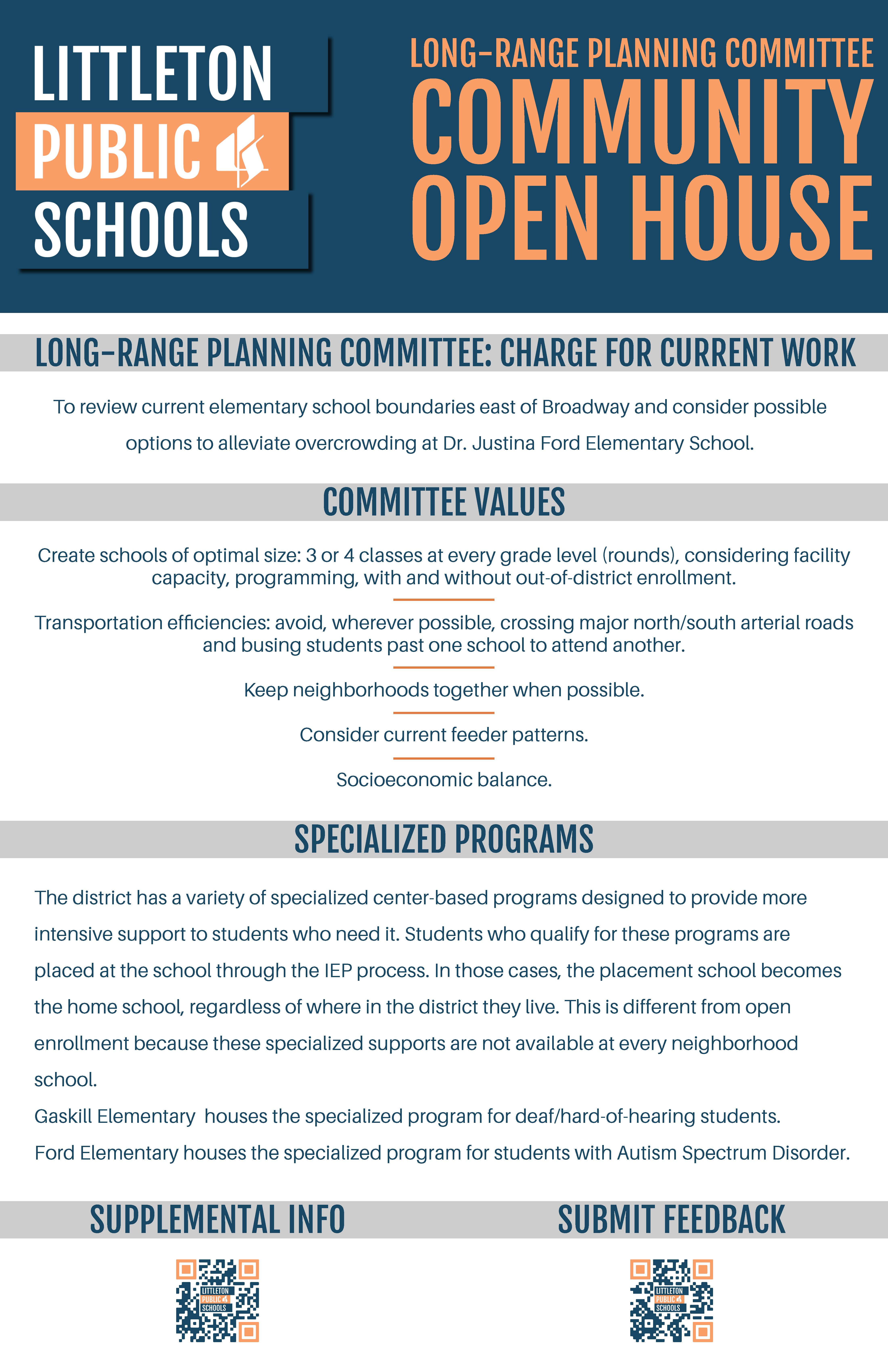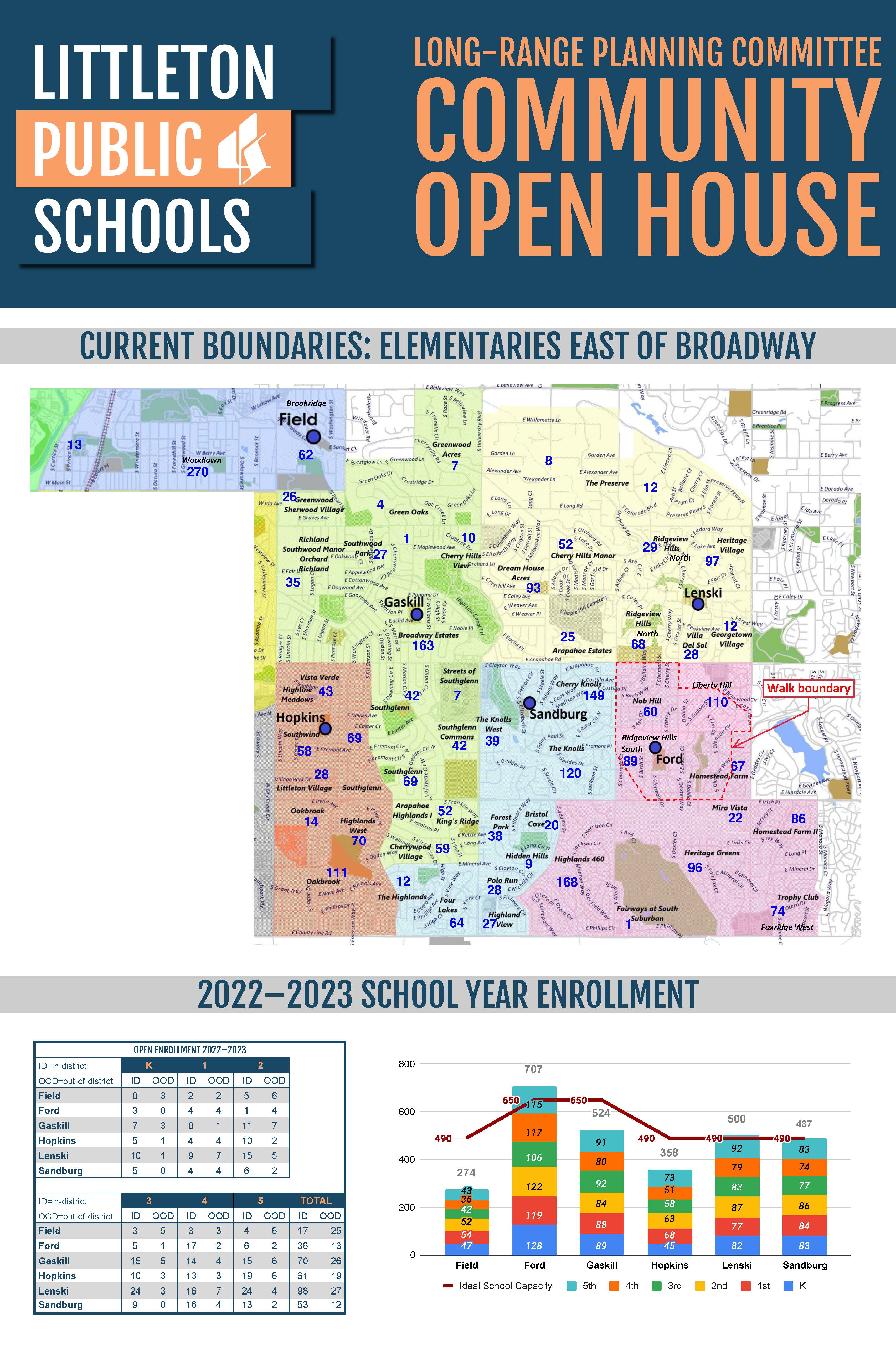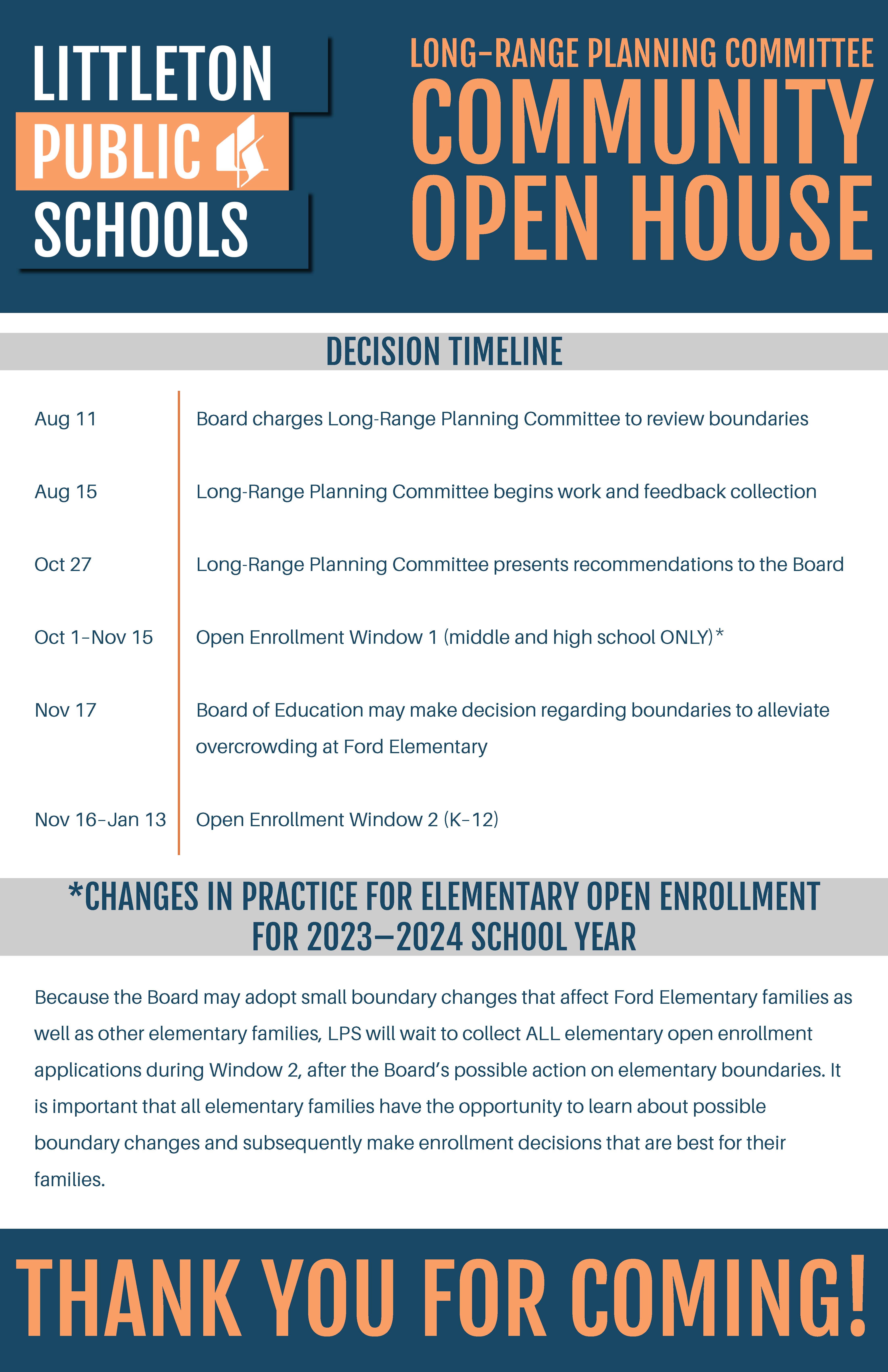LRPC History/Archives
Community Town Hall Input Sessions
Display Boards (click each to expand)
*PLEASE NOTE: The Long-Range Planning Committee meeting on September 28 has been moved to October 2 due to scheduling conflicts.
Supplemental Materials:
Demographic data supplied by Western Demographics
Boundary Scenario Forecasts 5 Year Projections data supplied by Western Demographics
Open and Out of District Enrollment by Grade Level for Elementary and Middle Schools
Elementary and Middle School Scenario Impacts
LRPC Elementary School Enrollment Information
LRPC Middle School Enrollment Information
School Bus Routes Scenarios.pdf
History of previous boundary changes
Ideal School Capacity
School class sizes are determined by the staffing formula (number of students per teacher) adopted by the Board of Education as part of the budget process as well as the number of sections (“rounds”) at each grade level in a school.
- Ideal capacity range of a 3-round elementary school is 450-500 students.
- Ideal capacity range of a 4-round elementary school is 600-650 students.
- Ideal capacity range of a middle school is 625-675 students. (Middle schools with fewer than 625 students must receive a subsidy from the district to maintain the same level of course offerings and student support)
LPS Long-Range Planning Committee invites you to give your feedback on the most recent elementary and middle school boundary possible options
Families of LPS elementary students who attend schools east of Broadway and families of LPS middle school students who attend schools east of Santa Fe:
The Littleton Public Schools Board of Education recently charged the district Long-Range Planning Committee to continue its review of elementary school boundaries east of Broadway and also review boundaries for middle schools east of Santa Fe. A subset of the original Long-Range Planning Committee is meeting this fall to review new data from the demographer, Western Demographics, which includes information on children aged birth to 4 along with the extensive, accurate data already reviewed by the entire Long-Range Planning Committee last year. The charge for this group is to bring two or three recommendations to the Board of Education in October that will better balance (right size) enrollment at Newton, Powell, and Euclid middle schools as well as all elementary schools east of Broadway, using the Board’s and Committee’s long-established standards and values when possible.
Taking all available data into account, Western Demographics provided possible options for the Committee’s consideration. The Committee spent its August meetings reviewing these possible options, ruling some out, and identifying two elementary and two middle school possible options to ask the community to weigh in on.
The Committee is hosting three identical Community Town Hall Input Sessions where attendees can drop in to learn about these possible options, ask questions, and provide feedback.
It’s important to remember that the boundary scenarios are possible options only. The Long-Range Planning Committee will take all feedback into account before finalizing its recommendations to the Board.
After reviewing all feedback, the Long-Range Planning Committee will provide its findings and recommendations to the Board of Education October 12, 2023. The Board has emphasized its desire to make decisions regarding boundaries by the end of October 2023–likely during the October 26, 2023 Board meeting - to give families as much time as possible to plan ahead.
Learn more about the ongoing work of the Long-Range Planning Committee on the district website. All materials reviewed by the Committee are available on the website as part of the Committee’s commitment to transparency. It is important to note that this includes possible boundary options no longer being considered by the Committee.
Community Town Hall Input Sessions:
Tuesday, September 19, 2023
5:30–7:00 p.m.
Powell Middle School
8000 South Corona Way
Littleton, CO 80122
Wednesday, September 20, 2023
4:00–5:30 p.m.
Euclid Middle School
777 West Euclid Ave.
Littleton, CO 80120
Thursday, September 21, 2023
5:30–7:00 p.m.
Newton Middle School
4401 East Arapahoe Rd.
Littleton, CO 80122
Fall 2023 Committee Work
The issue of school boundaries and the extensive, thorough work of the Long-Range Planning Committee has been ongoing for several years. The Committee continues to gather data, seek input, and investigate potential solutions to existing boundary challenges while planning for future enrollment fluctuations and population shifts.
Potential school boundary changes are a significant issue for LPS families and the community. Families build powerful bonds with their schools and teachers. Changing boundaries, even on a somewhat small scale, is a big deal.
Where we've been, where we are now, and where we are going
A year ago, the Board of Education charged the Long-Range Planning Committee to “review current elementary school boundaries east of Broadway and consider possible options to alleviate overcrowding at Dr. Justina Ford Elementary School.”
Long-Range Planning Committee members met from mid-August through mid-October in 2022. They reviewed Committee values, previous research and data, previous recommendations and Board decisions. They held two community open houses, which were well attended with about 100 community members each night. They reviewed emails, comment cards, and all of the feedback gathered from open house attendees.
They studied the feasibility of community member suggestions, the effects of different possible boundary change scenarios, actual enrollment, class size in elementary schools across the district, the impacts of open enrollment, and square foot per student comparisons.
All of this information was presented to the Board in the Committee’s report October 27, 2022.
The Long-Range Planning Committee recommended the Board make no adjustments to boundaries at that time, but consider doing a district demographic study and analysis of enrollment projections for the 2023–2024 school year, and continue to follow Board policy regarding open enrollment.
Before making a decision, the Board directed administration to provide information on two additional options, which would move various neighborhoods into different school boundaries.
In November 2022, administration presented data on the Board’s two additional options and also brought forward the Long-Range Planning Committee’s recommendation. The Board ultimately voted in favor of the Committee’s recommendation: to make no boundary changes at that time, to gather additional data including actual 2023–2024 enrollment, and conduct a districtwide demographic study.
In May of 2023, administration provided an update to the Board and proposed a timeline that would convene a smaller, more nimble subset of the Long-Range Planning Committee to review the demographer’s new data, which would include information on children aged 0–4 as well as his findings after visiting with city planners and local real estate experts. These new data would be added to the extensive, accurate data already reviewed by the entire Long-Range Planning Committee last year.
The smaller committee would host community engagement meetings and would then present its findings and recommendations to the Board, all in the span of about 9 weeks.
And during the May 23, 2023 meeting, the Board approved a motion to move forward with the proposed timeline.
The Board emphasized its desire to make decisions regarding boundaries by the end of October 2023 to give families as much time as possible to plan for the 2024–2025 school year.
That brings us to today.
The standards and values of the Long-Range Planning Committee have been in place since its inception in 2017 and remain in place today:
- Keep neighborhoods together when possible.
- Seek transportation efficiencies and avoid wherever possible crossing major north/south arterial roads, or busing students past one school to attend another.
- Create schools of optimal size: 3 or 4 rounds, considering facility capacity, programming, with and without out-of-district enrollment.
- Consider current feeder patterns to middle schools and high schools.
- Consider socioeconomic balance.
Nine long-standing and highly involved community members of the Long-Range Planning Committee representing current taxpayers who are also current and former parents make up the committee.
Terry Davis, chief operations officer, and Brad Leitner, director of operations, serve as staff liaisons. Other administrators including directors of elementary and secondary education, chief communications officer, chief information officer, assistant superintendent of learning services, and director of transportation, are asked to attend the meetings to observe, answer committee members’ questions, and support the work of the committee.
At the Committee's first meeting, it became apparent that the decision to stand up a smaller subset of the original committee with vast experience on the topic in order to work quickly was a good one. They dove right into the work. The group chose Jack Reutzel as the Chair of this smaller committee and named Lucie Stanish and Bob Colwell as Past Chairs who will help lead during the condensed timeline.
Demographer Shannon Bingham presented his new data and offered sample boundary solutions based on all data accumulated to-date. Members will continue to study these samples and asked Shannon to provide additional samples for the next meeting.
Three community town hall input sessions have been scheduled for September 19, 20, and 21.
The Committee and the Board will continue to conduct business openly and transparently, genuinely listening to the feedback regarding how families may be impacted, and being proactive with communication.
The Committee is scheduled to present its findings and recommendations to the Board in October. Recommendations could be made for the 2024–2025 school year or the 2025–2026 school year
Community Open Houses - Fall 2022
The Long-Range Planning Committee is hosting two identical community events where attendees can drop in any time during a two-hour open house to learn about the options being considered regarding overcrowding at Ford, ask questions of Committee members, and give feedback:
- Tuesday, October 4, 2022 from 4:30–6:30 p.m. at Powell Middle School
- Wednesday, October 5, 2022 from 6:30–8:30 p.m. at Powell Middle School
If you are unable to attend an open house, all of the content available to view and review is presented below.
Display Boards (click each to expand)
Supplemental Information
- Enrollment data:
Resident, Open Enrollment (in-district), and Out-of-District by School Pivot Chart
Resident, Open Enrollment (in-district), and Out-of-District by School Matrix - Options the Committee discussed These are ideas the Committee looked at but are not proposals the Committee has identified as possible solutions for Board consideration at this time. The Committee is still considering ideas and has not determined possible solutions for Board consideration. No decisions have been made. There is no guarantee that boundaries for any schools will change at this time.
- Open Enrollment page of Littleton Public Schools' website
- Presentation to the Board of Education regarding committee history, members, past and current work, and transparency (August 25, 2022) (watch meeting; presentation begins at approximately 1:48:29)
- Please also feel free to review agendas and minutes from committee meetings for further information (linked below in the 2022 Meeting Dates box)
Submit Feedback
Open house attendees had the option of submitting a feedback notecard or scanning the "Submit Feedback" QR code, which took them to a Google Form (feedback form closed on Friday, October 7 at 6:00 p.m.).
Board of Education approves LRPC recommendations to not change boundaries at this time
10.27.23
The Littleton Public Schools Board of Education approved both of the LPS Long-Range Planning Committee’s (LRPC) recommendations:
- Make no adjustments to elementary school boundaries at this time.
- Make no adjustments to middle school boundaries at this time.
On October 12, 2023, the LRPC presented these recommendations along with its findings to the Board. The LRPC carefully analyzed all of the information available, which included its research, most recent enrollment and forecasts, demographer-created boundary options, and community feedback. The LRPC gave careful consideration to the negative impacts changing boundaries have on students, families, neighborhoods, and school culture.
Elementary School Findings
- Data suggest that the short-term overcrowding at Ford can continue to be best managed at the district level through additional supports, as it is currently.
- Modifying boundaries to move essentially 40 students out of Ford is disproportionate to the harm done to the impacted school communities and neighborhoods.
- If the data projections are right, the district may need to consider boundary changes by 2026.
Middle School Findings
- Due to open enrollment, neither boundary change option provided by the demographer right-sizes Powell since impacted neighborhoods could just open enroll back to Newton.
- LRPC wonders if there are levers the district could pull to encourage more enrollment at Powell.
- If data trends are accurate, we may have to restart conversations regarding the future of both Powell and Euclid, and a plan will have to be made for that future. An interim step to try to solve low enrollment at Powell means continuous shifting for some students.
The LRPC also suggested – and the Board agreed – that the district continue to support schools including but not limited to Ford Elementary where larger pockets of enrollment exist.
Board members stressed that they read the hundreds of emails and comments from the community and clearly understood the weight of the decision before them. Board members agreed that changing boundaries should only be considered as a last resort and only when it is guaranteed to solve a problem. Based on all of the data, boundary changes do NOT necessarily solve issues of pockets of overcrowding that exist in a few elementary schools. Boundary changes at this time feel like an overreaction to a short-term issue, disrupt student stability, and disrupt school culture.
LPS Board President Angela Christensen extended another heartfelt thank you to the LRPC. “Thank you for your transparency throughout the process. You kept the community engaged and welcomed its feedback. All of the emotion, effort and energy that has gone into this process is a vivid reminder of how much we care about our students and their experience in LPS.
“I would also like to thank the community for its respectful and thoughtful feedback. Community members shared their own experiences, challenges, and successes in a really positive way. This does not always happen in our neighboring districts and it makes me incredibly proud to call this district my home.”
Christensen noted that a decision to not change physical boundaries doesn’t mean we are doing nothing.
Superintendent Dr. Todd Lambert agreed. “District leadership started a solutions conversation this week, and we expect to bring those solutions to the Board November 16.” Dr. Lambert thanked Chief Operations Officer Terry Davis as well as LRPC Co-Chairs Jack Reutzel, Bob Colwell, and Lucie Stanish for their outstanding leadership throughout this process.
While the elementary enrollment issue is projected to correct itself in the next few years, district leaders noted that they will need to get creative to address low enrollment at the middle school level as enrollment at all levels continues to decrease in the Denver metro area and across Colorado.
The Board thanked LRPC members for their years of dedicated volunteer service on these complex topics and thanked them for providing relevant data, thoughtful reflections, and recommendations that take into consideration not only the data and feedback, but also the emotional impact of its recommendations.
Last night’s Board action followed the expected timeline and wrapped up a two-year process as the LRPC considered boundaries and enrollment. The Committee presented three recommendations for both elementary and middle school in rank order to fulfill the Board’s charge. The Board agreed that the other recommendations, which changed boundaries, were not desirable at this time. You can access the LRPC presentation through this link.
Dear families of LPS elementary students who attend schools east of Broadway
The Littleton Public Schools Board of Education recently charged the Long-Range Planning Committee to review current elementary school boundaries east of Broadway and consider possible options to alleviate overcrowding at Dr. Justina Ford Elementary School.
The committee is hosting two identical community events where attendees can drop in any time during a two-hour open house to learn about the options being considered, ask questions of Committee members, and give feedback:
- Tuesday, October 4, 2022 from 4:30–6:30 p.m. at Powell Middle School
- Wednesday, October 5, 2022 from 6:30–8:30 p.m. at Powell Middle School
Comité de Planificación a Largo Plazo encargado de estudiar los límites de las escuelas primarias al este de Broadway; el Comité busca la opinión de la comunidad
Estimadas familias de estudiantes de escuelas primarias de LPS, que asisten a las escuelas al este de Broadway:
La Junta de Educación de las Escuelas Públicas de Littleton encargó al Comité de Planificación a Largo Plazo del distrito revisar los límites actuales de las escuelas primarias al este de Broadway y considerar posibles opciones para aliviar la sobrepoblación de la Escuela Primaria Dr. Justina Ford. El Comité se reunirá hasta octubre para estudiar las tendencias actuales de inscripción y reunir información de la comunidad.
El Comité ha organizando dos eventos comunitarios idénticos que los asistentes pueden visitar en cualquier momento durante la sesión de puertas abiertas de dos horas para conocer las opciones que se están considerando, así como hacer preguntas a los miembros del Comité y dar su opinión:
- Martes 4 de octubre de 2022 de 4:30 a 6:30 p.m. en la Escuela Secundaria Powell
- Miércoles 5 de octubre de 2022 de 6:30 a 8:30 p.m. en la Escuela Secundaria Powell
Members
The committee is comprised up to 16 voting members representing the following interest groups:
- District Accountability Committee
- Financial Accountability Committee
- Citizens' Bond Oversight Committee
- Educational Technology Advisory Committee
- Special Services Advisory Committee
- PTO Presidents Council
- LPS charter schools
- Parents
- Community members
- Senior community members
- South Suburban Parks and Recreation District
- YMCA of Littleton
- Optimists' Club
Background
In the spring of 2017, LPS began to explore how to streamline school start and end times to better meet the needs of teenagers and to pave the way for improved and more efficient transportation services in the future. Research tells us that a later school start time positively impacts alertness, mental health, wellness and behavior in high school and middle school students, which means students are better prepared to learn.
Community conversations about the possibility of changing school start times began last spring through 22 staff and 30 parent/community meetings throughout the school district. In addition, nearly 6,000 parents, staff and secondary students participated in a survey about potential changes to school start times. The LPS Board of Education asked the Long-Range Planning Committee to further study the issue and provide the Board with recommendations in November 2017.
Boundary Study
The committee has been meeting since the fall of 2018 to study school boundaries to better balance enrollment, provide boundaries for the new elementary schools to be built for the Ames neighborhood and the combined Highland and Franklin neighborhoods, and to address the growing transportation challenges resulting from increased traffic in the south metro area -- all in an effort to improve boundaries to best serve students and provide them with the best educational experience possible.
During more than 20 hours of meetings, the LRPC has considered 14 different elementary school boundary scenarios, six different middle school boundary scenarios, and four different high school boundary scenarios. As part of this process, the LRPC:
- Looked for logic and efficiency as new boundaries were considered.
- Strived to keep neighborhoods together, recognizing that waterways and other obstacles make transportation more difficult.
- Found boundary solutions for the new neighborhood school on the Ames campus.
- Found boundary solutions for the new neighborhood school on the current Franklin campus.
- Strived to avoid wherever possible having to cross major north/south arterial roads, busing students past one school to attend another, and creating a smaller-than-optimal schools.
- Considered current feeder patterns (elementary to middle to high).
- Considered school size and capacity, with and without out-of-district students.
- Considered socio-economic balance.
- Looked toward the future: what building replacements are happening with the current bond, and what buildings might be replaced in future bonds? How will boundaries be impacted?
Four stakeholder open houses were scheduled in January and February 2020, where attendees could drop in any time during a two-hour open house to learn about each scenario, ask questions of LRPC members, give feedback and take an exit survey, which provided another opportunity for feedback.
All four open houses provided attendees with the same opportunities to interact with members of the Long-Range Planning Committee, learn about the boundary options, ask questions, and provide feedback. All returned surveys were tabulated verbatim in a spreadsheet for LRPC members to review as they draft their final recommendations to the Board of Education, to be presented later this spring. Additionally, feedback received via emails, phone calls, and letters was also recorded for the committee's review.
What’s next?
The LRPC will provide an update to the Board of Education later this spring. The Board is tentatively scheduled to make decisions about the boundaries by the fall of 2020, and approved new boundaries would likely take effect in the fall of 2021.
Additional information about the Districtwide Boundary Study is available on the LPS district website at Boundary Study.
Summary of February 2017 Start Time Survey Results
In February 2017, nearly 6,000 parents, staff members and middle/high school students participated in a survey about potential changes to school start times. The survey asked participants to react to one specific option.
Parents and staff members who participated in the survey indicated:
- 74% approve of an 8:30 a.m. school start time and a 3:30 p.m. dismissal time for high schools
- 65% approve of a 9 a.m. school start time and a 4 p.m. dismissal time for middle schools
- 68% approve of an 8 a.m. school start time and a 2:45 p.m. dismissal time for elementary schools
- 91% of high school survey participants and 83% of middle school participants said they would use the extra time in the morning to sleep
Summary of October 2017 Start Time Survey Results
In October 2017, LPS employees and parents were invited to participate in another survey regarding possible changes to school start times. 6,305 parents and employees responded. It was a self-selected survey with a response rate of 36%. Participants were asked to indicate preferences of a possible change to school start times among three choices: Option 1, Option 2, and No Change (see the chart below.) Participants were asked their first choice and their second choice.
Survey results indicate:
- More than 66% of all parents prefer a change to school start times. They are fairly evenly split between Option 1 and Option 2 as their first choice. This also holds true among individual parent groups.
- 66% of preschool and elementary school parents want change as a first choice.
- 62% of middle school parents want change as a first choice.
- 65% of high school parents want change as a first choice.
- 55% of all LPS employee respondents prefer change (or have no preference) and are evenly split between Option 1 and option 2 as their first choice.
- Nearly 74% of preschool and elementary school employees want change as a first choice.
- 60% of middle school employees prefer No Change as their first choice.
- 60% of high school employees prefer No Change as their first choice.
October 2017 survey results were presented to the Long-Range Planning Committee in early November, 2017. View the presentation.
Recommending a Bond Election
The Long-Range Planning Committee recommended in August 2018 that the Board of Education put a bond question on the November 2018 ballot. View the committee's report to the Board.
2023 Meeting Dates
2022 Meeting Dates
The Board of Education reconvened the LRPC at the Board meeting on August 11, 2022
Meetings will be held from 4:30–6:30 p.m. at the Education Services Center
| August 15, 2022 | Agenda / Minutes |
| August 29, 2022 | * Meeting at Gudy Gaskill Elementary School Agenda / Minutes |
| September 12, 2022 | Agenda / Minutes |
| September 26, 2022 | Agenda / Minutes |
| October 10, 2022 | Agenda / Minutes |
| October 17, 2022 | Agenda / Minutes |
2021 Meeting Dates
Meetings are held from 4:30–6:30 p.m. Virtually.
Observing Virtual Advisory Committees
| January 12, 2021 | ONLINE MEETING Agenda / Minutes |
| January 26, 2021 | ONLINE MEETING Agenda / Minutes |
| February 9, 2021 | ONLINE MEETING Agenda / Minutes |
| February 23, 2021 | ONLINE MEETING Agenda / Minutes |
| March 9, 2021 | ONLINE MEETING Agenda / Minutes |
| April 20, 2021 | ONLINE MEETING Agenda / Minutes |
| Tentative May 4, 2021 |
CANCELLED |
2019–2020 Meeting Dates
Meetings are held from 4:30–6:30 p.m. at the Education Services Center.
| Aug. 19, 2019 | Agenda / Minutes |
| Sept. 30, 2019 | Agenda / Minutes |
| Oct. 28, 2019 | Agenda / Minutes |
| Nov. 11, 2019 | Agenda / Minutes |
| Dec. 9, 2019 | Agenda / Minutes |
| Jan. 13, 2020 | Agenda / Minutes |
| Feb. 24, 2020 | Agenda / Minutes |
| Mar. 9, 2020 | Agenda / Minutes |
| Mar. 30, 2020 | CANCELLED |
| Apr. 10, 2020 | ONLINE MEETING Agenda / Minutes |
| Apr. 16, 2020 | ONLINE MEETING Agenda / Minutes |
| Apr. 30, 2020 | ONLINE MEETING Agenda / Minutes |
| May 18, 2020 | ONLINE MEETING Agenda / Minutes |
2018–2019 Meeting Dates
| July 16, 2018 | Site Visits |
| July 30, 2018 | Agenda / Minutes |
| October 22, 2018 | Agenda / Minutes |
| November 12, 2018 | Social Event |
| January 28, 2019 | Agenda / Minutes |
| February 4, 2019 | Agenda / Minutes |
| March 4, 2019 | Agenda / Minutes |
| April 2, 2019 | Agenda / Minutes |
| April 22, 2019 | Agenda / Minutes |
| May 6, 2019 | Agenda / Minutes |
2017-2018 Meeting Dates
| April 5, 2017 | Agenda / Minutes |
| May 17, 2017 | Agenda / Minutes |
| June 7, 2017 | Agenda / Minutes |
| June 14, 2017 | Agenda / Minutes |
| August 14, 2017 | Agenda / Minutes |
| September 11, 2017 | Agenda / Minutes |
| September 18, 2017 | Agenda / Minutes |
| October 2, 2017 | Agenda / Minutes |
| October 16, 2017 | Agenda / Minutes |
| November 6, 2017 | Agenda / Minutes |
| December 18, 2017 | Agenda / Minutes |
| January 22, 2018 | Agenda / Minutes |
| February 5, 2018 | Agenda / Minutes |
| February 26, 2018 | Agenda / Minutes |
| March 5, 2018 | Agenda / Minutes |
| March 19, 2018 | Agenda / Minutes |
| April 2, 2018 | Agenda / Minutes |
| April 16, 2018 | Agenda / Minutes |
| May 1, 2018 | Agenda / Minutes |
| May 7, 2018 | Agenda / Minutes |
| May 21, 2018 | Agenda / Minutes |
| June 4, 2018 | Agenda / Minutes |
| June 18, 2018 | Agenda / Minutes |



Timeline
Spring 2017
- Superintendent Brian Ewert presented options for possible start time changes at more than 50 staff and community meetings.
- Staff, parents and middle and high school students were invited to take a survey regarding possible start time changes.
- Long-Range Planning Committee (LRPC) was given a charge by the Board to review start times and research.
June 2017
- LRPC examined synopses of studies by Kyla L. Wahlstrom, Ph.D. (University of Minnesota) and Lisa J. Meltzer, Ph.D. (National Jewish Health).
- LPS Transportation presented viable scenarios to LRPC.
- Dr. Scott Siegfried (Cherry Creek School District) presented Cherry Creek’s research and process surrounding their change to start times to LRPC.
August 2017
- Lisa J. Meltzer, Ph.D. (National Jewish Health) presented her research in person to LRPC.
- LRPC discussed viable scenarios put forth by Transportation and chose two based on research presented to the committee.
September 2017
- LRPC conducted community outreach meetings.
- Lisa J. Meltzer, Ph.D. (National Jewish Health) presented her research in person to Board of Education
October 2017
- LPS employees and parents were invited to participate in a survey regarding possible changes to school start times
- LRPC reviewed and discussed community feedback.
November 2017
- LRPC made a recommendation to the Board of Education: “Littleton Public Schools adopt Option 1 start times for the 2018-2019 school year, with Option 2 as a secondary option for the Board to consider.”
View the Committee's presentation to the Board of Education November 16, 2017- Please visit the School Start Times page to view new start and end times for the 2018-2019 school year
Researchers Say:
“Advances in understanding sleep and circadian regulation, and the negative consequences of missing two to three hours of sleep a day to meet the demands of education time, give us a new understanding of adolescent behavior. We now know it is their biological clocks, not laziness, that keeps them in bed in the morning and up late at night. Fortunately, the problems of short sleep duration and sleep deprivation caused by education time is one that can be solved by synchronizing adolescent education time to adolescent biology.”
Paul Kelley
"Synchronizing education to adolescent biology: ‘let teens sleep, start school later’"
Learning, Media and Technology, Volume 40, 2015 - Issue 2: Neuroscience and Education
“While long seen as a cultural and psychosocial preference, later bedtimes among adolescents are now understood to be a biological response to puberty, the onset of which results in a two-hour sleep-wake phase delay without lessening total sleep requirements. Therefore, adolescents have a biological need to be able to sleep later in the morning.”
"School Start Times: Review of Recent Literature"
Hanover Research






